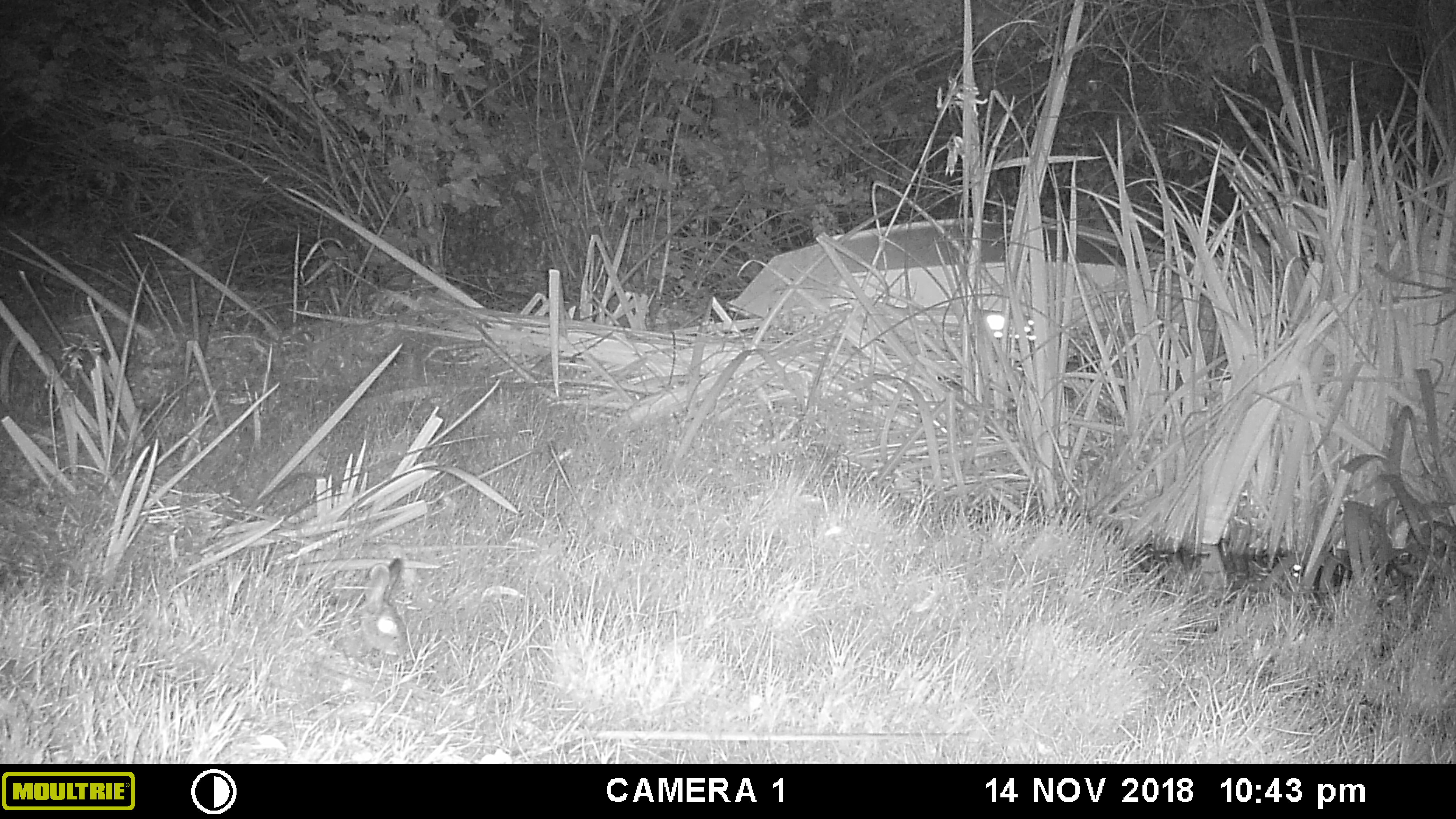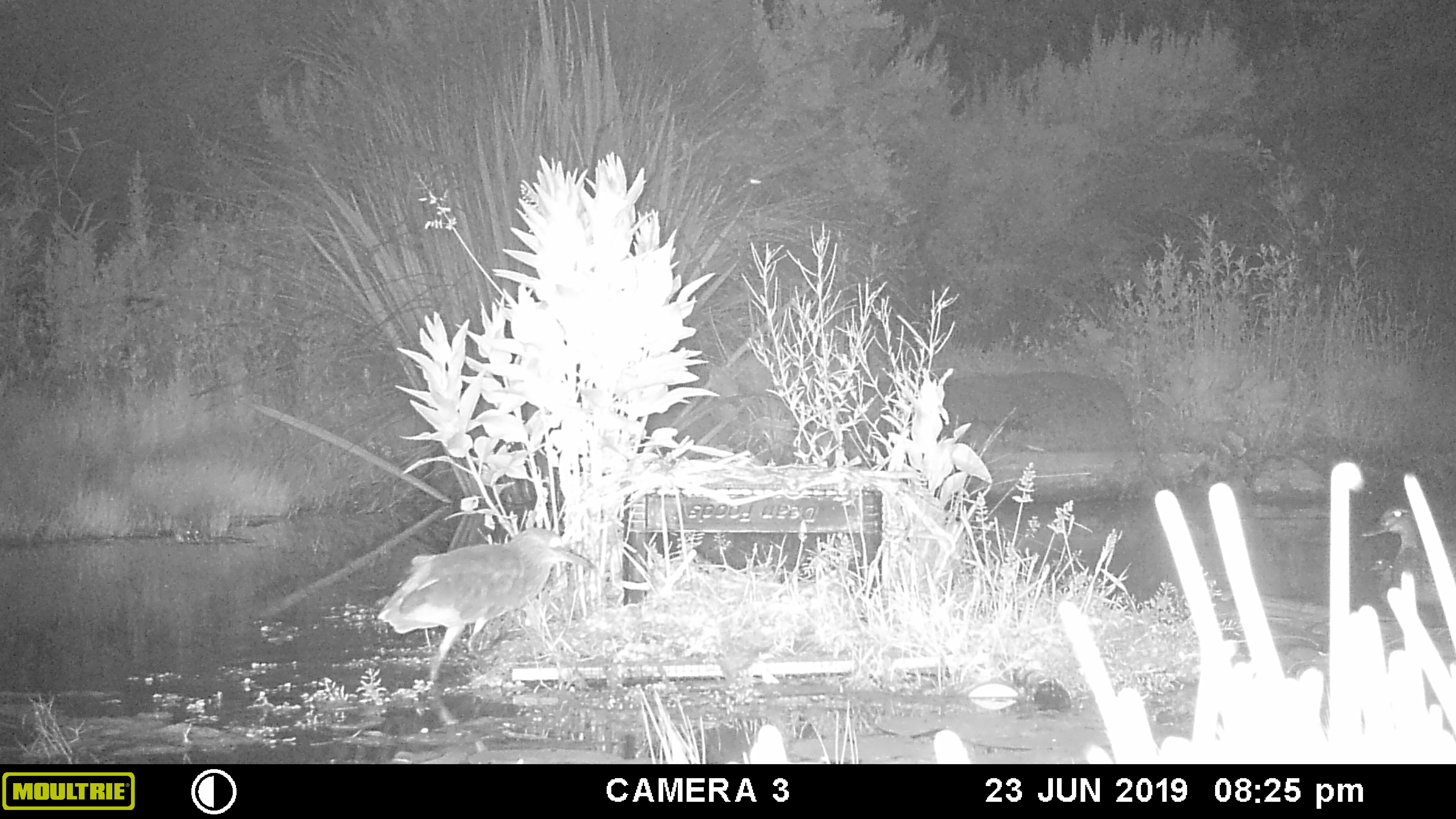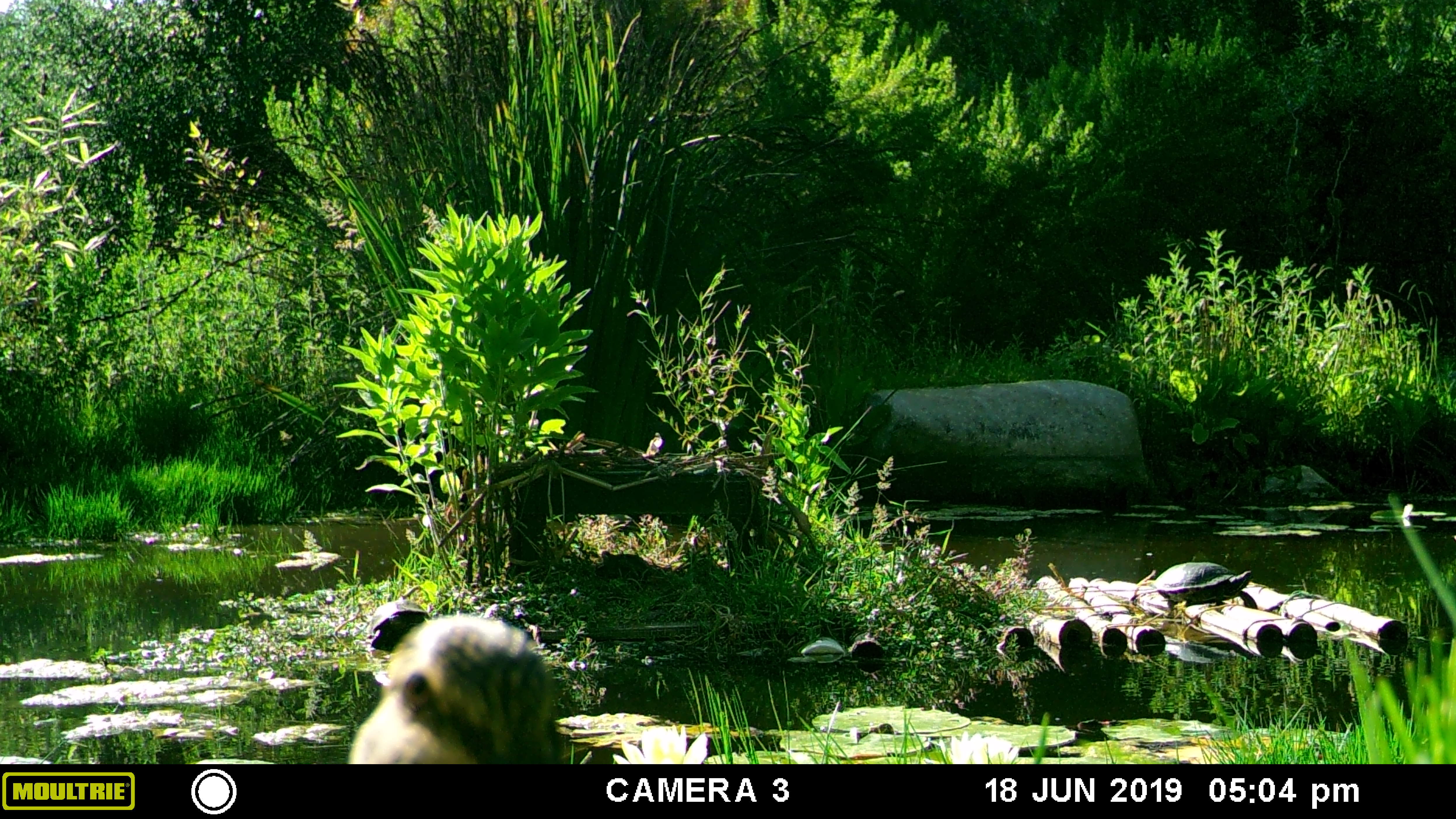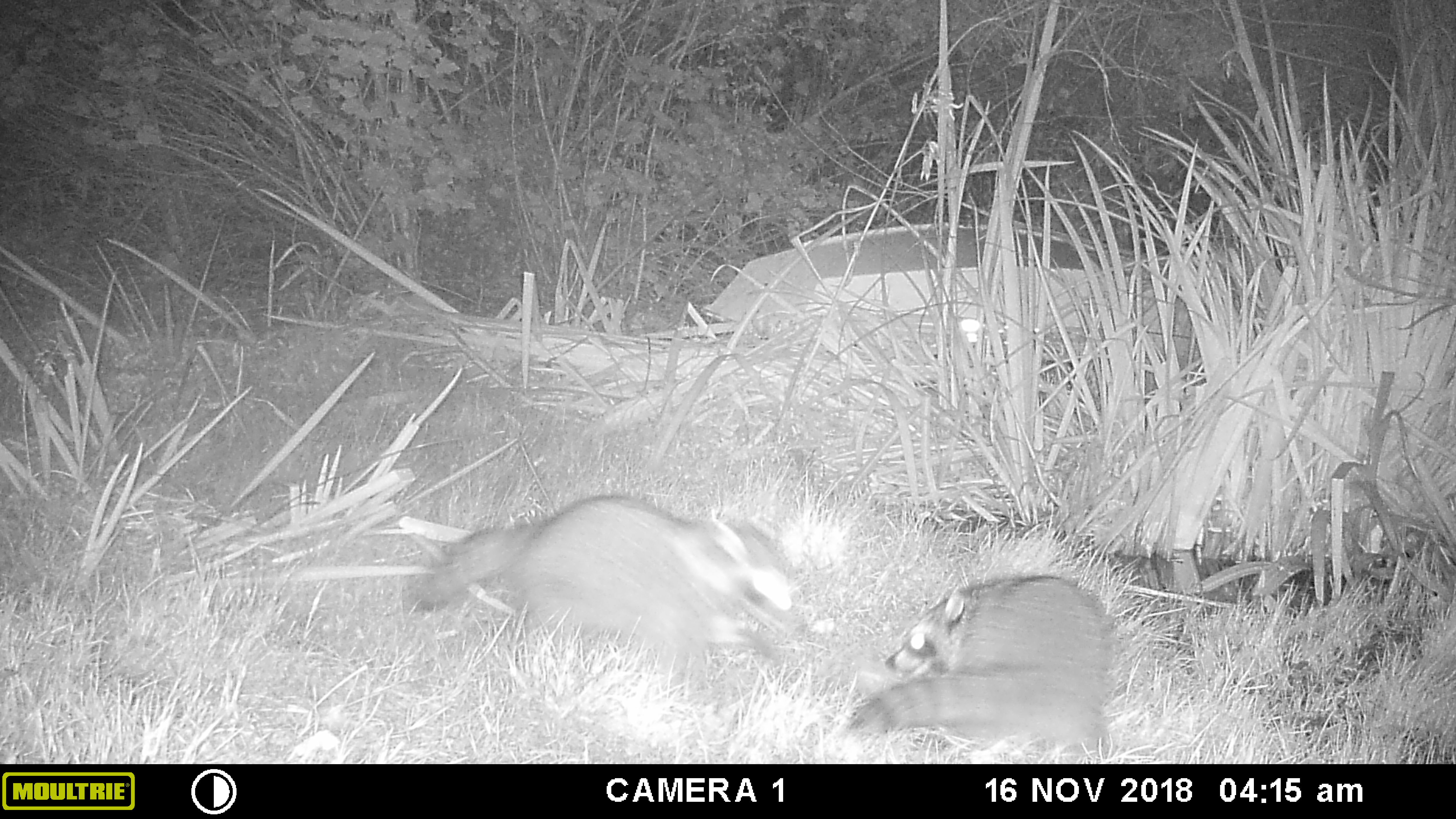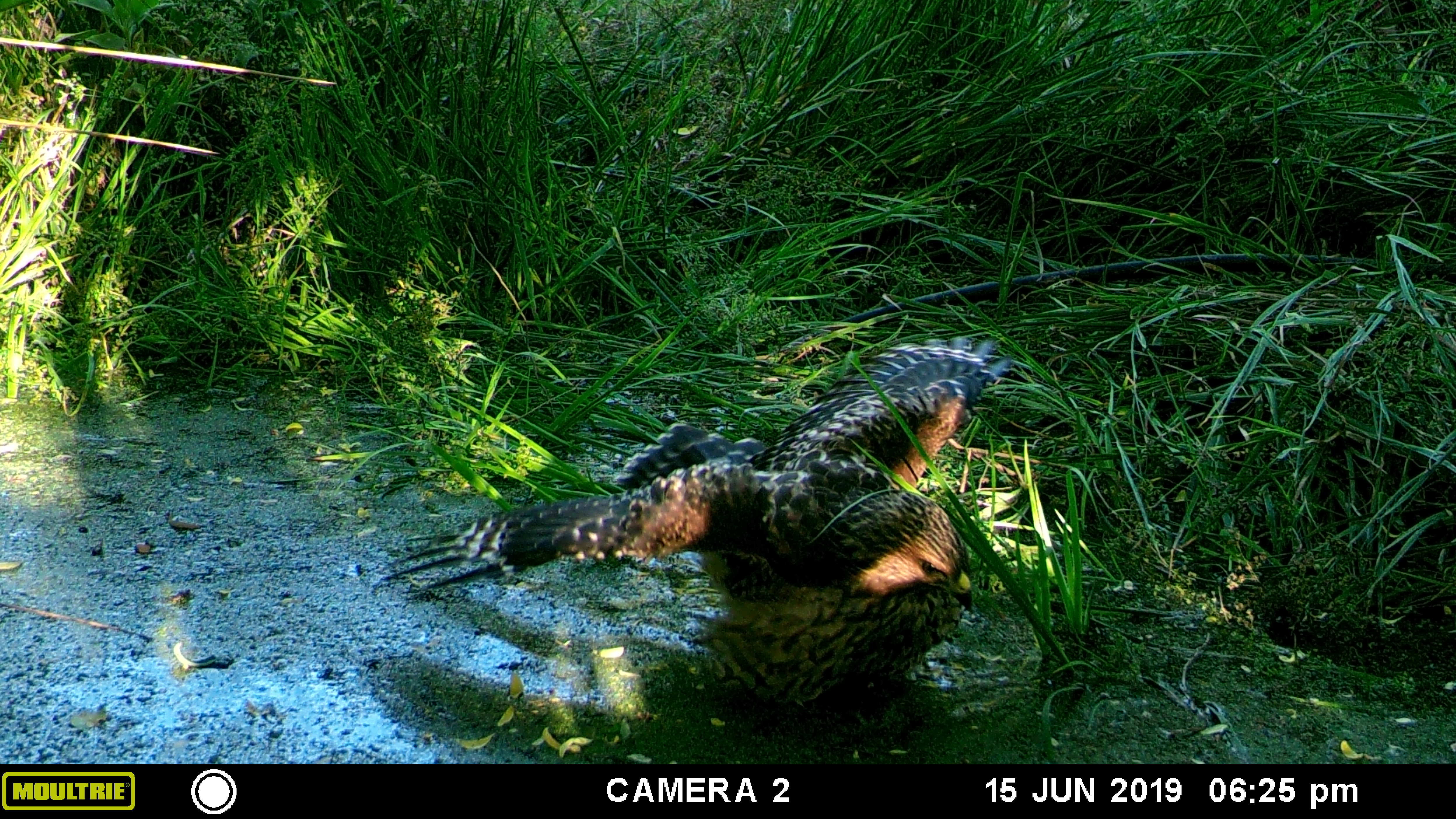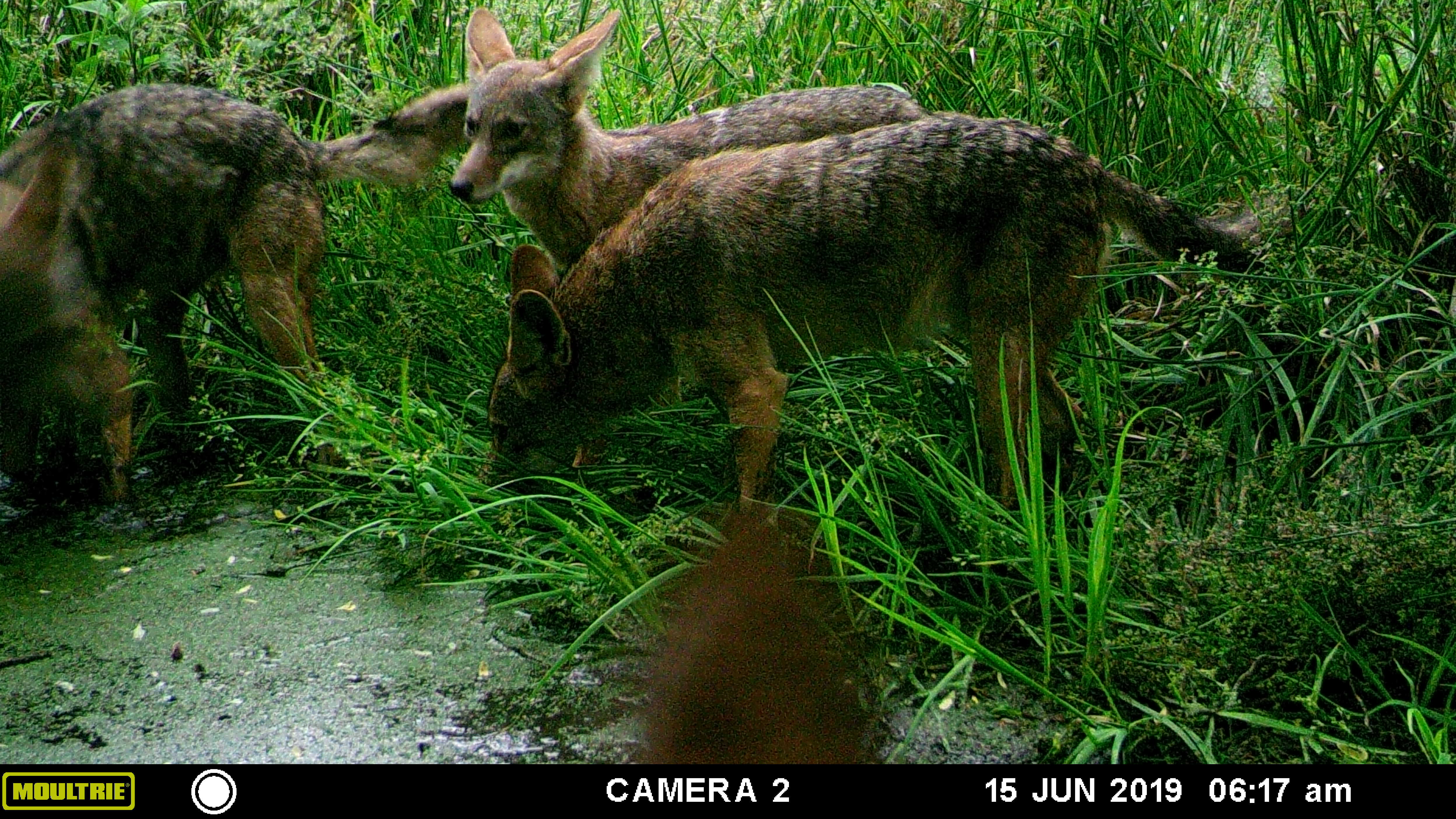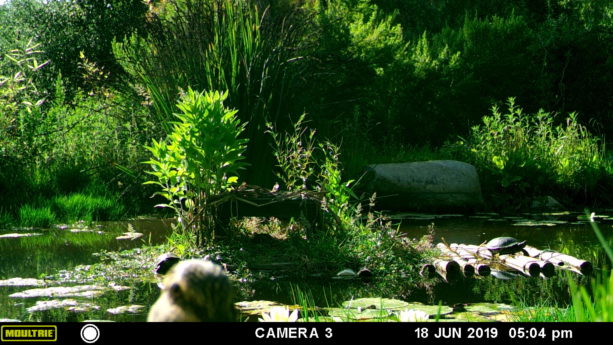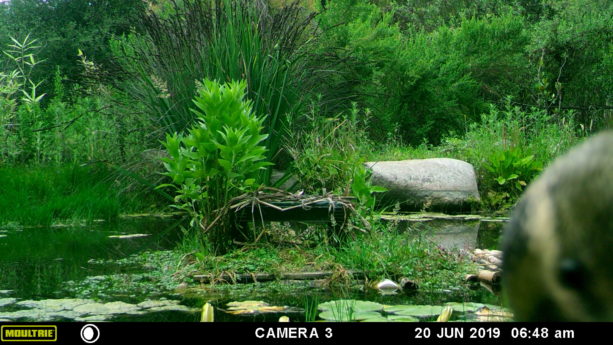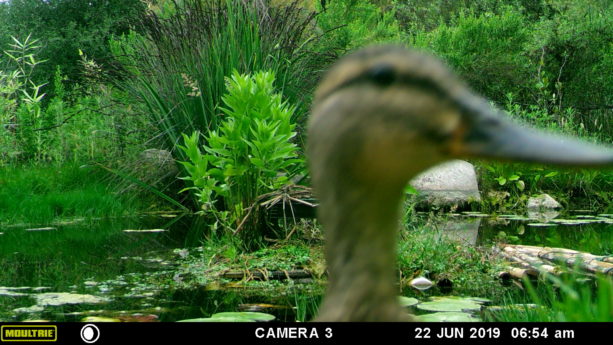-
The Púkas of Caerbannog
 POND FROLICS
POND FROLICS
Finch Frolic is home to many Desert Cottontails.

Dah-DUM. Dah-DUM. Dah-DUM, dah-DUM, DAH-DUM –! More all the time, in fact.

“Whoa! Do you see what I see?” “Yeah, yeah — when did that rabbit get there?” Or at least very solid population replacement.
We see them all the time because they are pretty comfy here and used to us, just scooting around nibbling grasses and fighting the ducks (I gotta see if I have photos of that to share — hilarious bunny sass…).
The funny thing is how infrequently they appear on the wildlife cameras, and when they do, they’re invariably being rather sneaky.
“Oops, still in shot, sorry.” 


Sometimes, it can start to feel a little spooky….
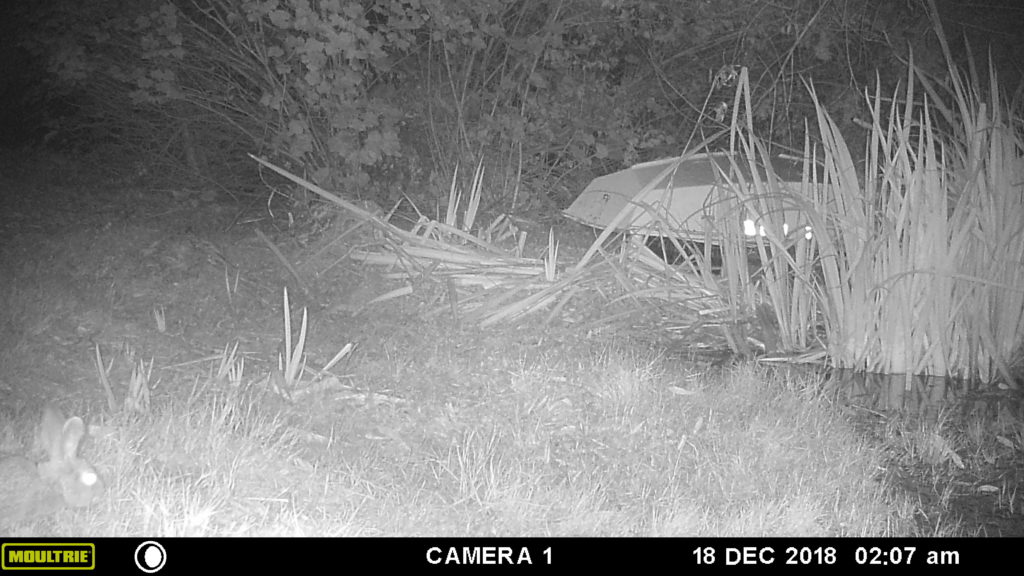
(Nasty, big, pointy teeth.) 
— Run awaaaay!
-
Coon Tales: The Beginning
 POND FROLICS
POND FROLICS
When we first put out our wildlife camera over the big pond’s north bog, we quickly found that aside from the oppressive scourge of the querulous ducks, raccoons are our most frequent visitors.

“Ooo — I wonder if that little red light is edible?” 
“I can just sneak right up on it….” 
“Hmm — nothing inside this shell to eat. A pointless object.” The story they present is also generally a much more compelling one than the ducks’ — they both have intrigue, romance, action and comedy, but when you’ve watched ducks go back and forth and back and forth and back and forth in petty squabbles for the zillionth time, you come to respect the way the coons economize their time.

INTRIGUE 
COMEDY 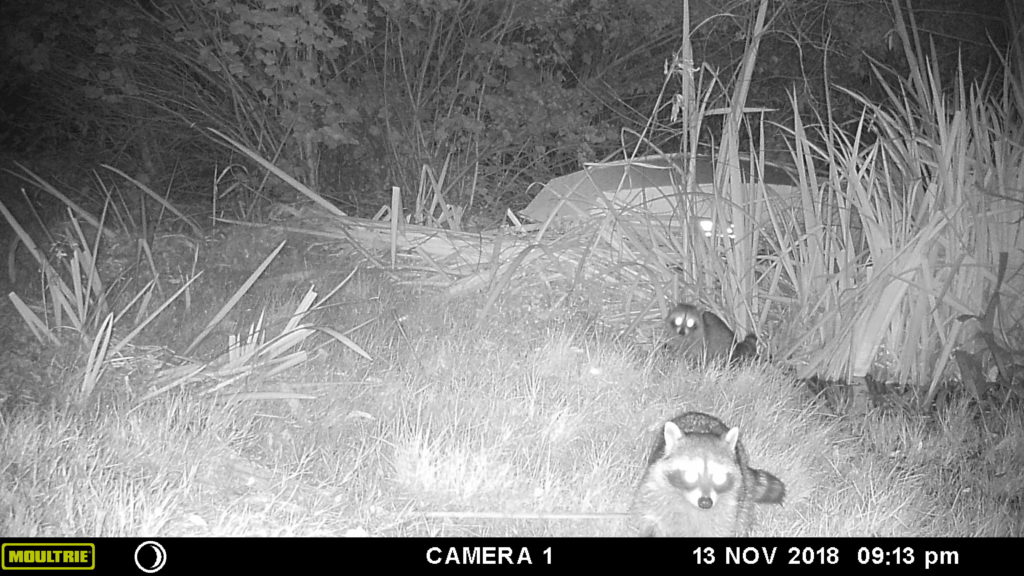
ROMANCE 
ACTION The ducks take the whole day to execute their drama, but the raccoons squeeze it all into night visits lasting only a few minutes, perhaps a quarter of an hour.
Or perhaps only the time it takes to capture a single, perfect picture.
-
Getting Your Feet Wet
 POND FROLICS
POND FROLICS

“Oooo that is definitely squlechier than I expected–!” Either this juvie Red-shouldered Hawk (Buteo lineatus) thinks she just caught something or she’s just realizing bathwater with duckweed might not be the best choice….



Subduing an unfortunate young bullfrog? Carefully scraping off tiny, free-floating aquatic plants? Blocking out a new rhythmic gymnastics routine? We’ll never know.
-
From Heron Out
 POND FROLICS
POND FROLICS
Lessee, what can I tell you about the Black-crowned Night-Heron (Nycticorax nycticorax)….
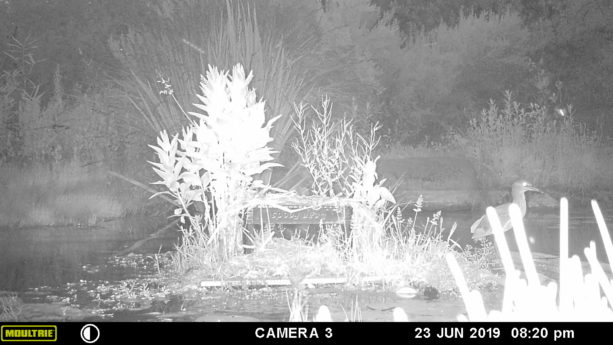
“WHOA, what was that back there? Gotta check that out….” There’re small herons. They have blackish feathers on top of their heads. I guess you could call it a cap. A blackish cap.

“They were fast – as – light – niii-ing–!” They’re the most widespread species of heron in the world, apparently. Noisy, social, not too fussy.
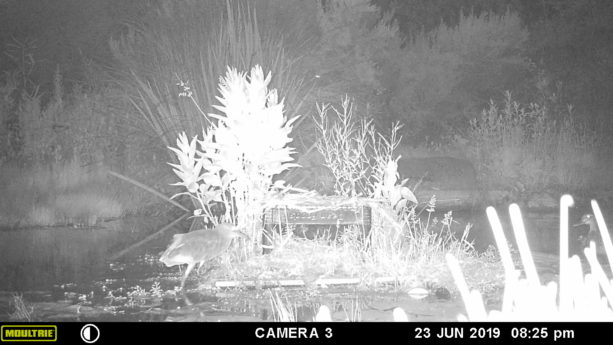
“Hey! What’re you lookin’ at, lady?” Oh, and this is surprising: they do most of their hunting and such at night or in the dusk: evening and early morning. Herons of dimness. Darkling herons. Gloaming. Blackish-capped. Herons.
…Yep. -
New Wildlife Camera Angle
-
Puppy Time
 POND FROLICS
POND FROLICS

Four silly yappi-yotes! We viewed the latest batch of wildlife camera photos the other day and were treated to a stop-motion movie of young coyote antics in the back of the little pond. Every year, we’ve only had the evidence of crepuscular play, so it’s nice to finally get an idea of what shenanigans resulted in the traces left for us (I refer you to the episode of the Great Snake Vanishment). Critically, we gleaned important clues in the mystery of how the hose that tops up the ponds from the well got kinked; 12 hours we put the station on, and the pond level got lower!
Puppies, y’know?


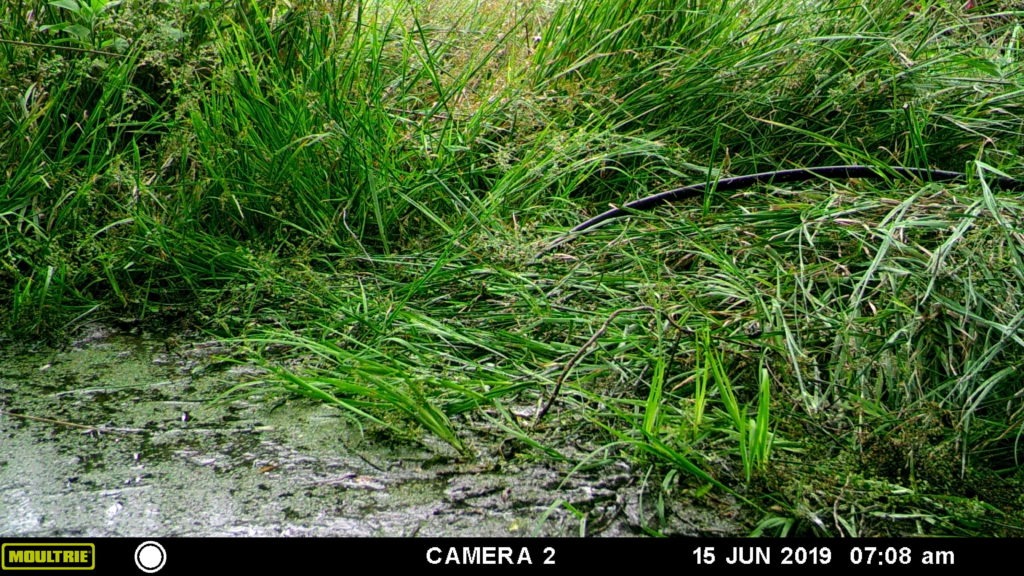

* Yeah. We do good work. * -
M’s Turk-ish Eggplant Stew
Miranda here, posting a recipe by request.
So here’s the deal. Eggplants are creepy.
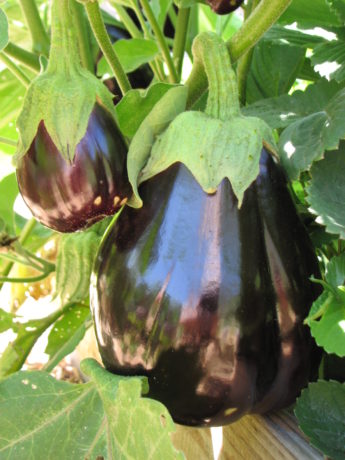
Don’t get me wrong, I think they is one fine looking piece of … fruit? vegetable? alien pod? whatever. And so much variety in shape, size, colour, etc., that the eggplant area of my life is delightfully well-spiced (you know, ‘variety is the spice of life‘…. Okay). I dig it.
But … they also seem kinda poisonous, and like, what’s up with being the texture of wet packing foam fresh and like the lovechild of a mushroom and a whelk when cooked? I see you decided to go with ‘slippery’. Well played Mme. Aubergine, well played.It’s taken me a long time, an exercise of my palatal boundaries (aging, as Shakespeare noted, does play dickey with our tastes), and an interest in slaking my mother’s insane hunger for eggplant to reach parley with this ‘edible’.
I’ve disCOVered … it’s quite nice. Mixed with other stuff. Cooked like, a lot, usually with spices. Hey, does everybody want a bouquet of only baby’s breath? No. I like my textures diverse, and my baba ganoush like, 90% pita chip.
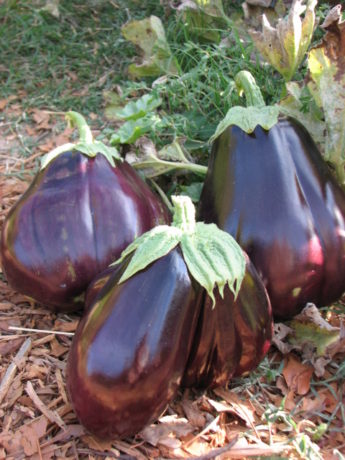
To get to the point, I composed this delish eggplant recipe with reference to Almost Turkish Recipes’ Vegeterian Eggplant Stew (Etsiz Patlican Güveç) and Taste.com’s Beef and Eggplant Stew and a hearty helping of rugged individualism. It came out preh-tay awesome, I am required by inherent truthfulness to say. Diane loves it for its rich layers of flavour and healthy, hearty vegetabliness that make it the perfect combination of comforting and exotic. There’s something for everyone in there! Plus, you can stroke some more hash marks into your summer “Zucchinis/Eggplants/Tomatoes ENDED” tally with a sauce-stained smile once you’ve roused yourself from your stewy food-coma.
Celebrate the small victories.
(Mme. Aubergine can celebrate a gracious concession from one former eggplant separatist.)
Enjoy.
M's Turkish Eggplant StewPrep time:Cook time:Total time:Serves: 3-4The perfect combination of comforting and exotic, and an amazing way to use up summer vegetables.Ingredients- 1 large eggplant (larger than big grapefruit) or equivalent amount of smalls
- 1 zucchini about 6 in. long (soft center cut out) or equivalent amount of smalls
- 3 medium potatoes, peeled
- 3 seitan filets (equivalent to 4"x4" each) or other vegetarian protein product, cut into bite-sized pieces
- 1 medium onion, chopped thin
- 1 large clove garlic, minced unless you like larger pieces
- 1 tsp. ground cumin
- ½ tsp. ground cinnamon
- 1 tbsp. thick tomato product: tomato paste, fresh tomato concoction, specialty ketchup, etc.
- 1½ cups broth (I have used leftover broth from making seitan before, or veggie broth)
- 1 tbsp. sesame oil, more or less
- 1 tbsp. olive oil, more or less
- Black Pepper to taste
- [Optional additional spices, in any combination: ½ tsp. ground ginger, 1 tsp turmeric, 1 tsp. ground paprika, Touch of chili/pepper of some sort]
Instructions- Use vegetable peeler to stripe the eggplant and zucchini lengthwise. Chop into ~ 1 in. pieces, or to preference (eggplant will shrink in cooking, so can leave larger chunks).
- Chop potatoes smaller (1/2") to keep cooking time down.
- Heat a large pan (I prefer to use our flat-bottomed wok) on high until very hot.
- Toss in eggplant and zucchini as well as potatoes and seitan and allow to sear, stirring on and off to prevent burning.
- Drizzle some sesame oil and/or olive oil around the edges of the pan to stop the searing and allow the veggies and seitan to begin to fry.
- When seitan begins to brown a bit, turn down the heat and add the onion and garlic. Cook, stirring, until onions are browning (don't allow garlic to burn, as it cooks faster than onion).
- Add spices and ketchup, and stir on medium-low for a few moments to fully incorporate.
- Pour in broth and stir well.
- Cover, and set to simmer for 30 min. If it's looking too soupy towards the end, remove the cover and raise the heat until it's less liquidy, but it should be like a thick stew.
- Serve with rice or couscous.
NotesWe count on the excellent leftovers, so I always make extra, but it is filling so portion size may be smaller for some. May also be made a few hours early, left in the pan on the stove and reheated to serve. For seitan recipe see Diane's post: http://www.vegetariat.com/2015/01/seitan/.
MCK - Animals, Culture, Gardening adventures, Humor, Photos, Ponds, Predators, Reptiles and Amphibians, Water
Turtle Recall
Howdy there — it’s Miranda popping in from the Facebook page to bring you a cool update. It’s been quite a while since my last post on Vegetariat: I mostly leave all the easy-peasy blog work to Diane while I’m concentrating on the excruciatingly complex and tiring Facebook stuff. I know, I’m a saint. Hey, did you know old Shakespeare the Bard invented the name Miranda? — it’s the feminine form of the Latin gerund mirandus, meaning “worthy to be admired”; so really I’m Saint Admirable of Vultusliber. (One in there for the dead language folks, thank me in the comments — or, you know, not.)
Today I want to tell you a story about some ponds, and some turtles, and some recollections. No elephants.
Those who visit us on the Facebook page may already know of our glee last April when a pair of Southern Western Pond Turtles (Actinemys pallida) appeared in our big pond.
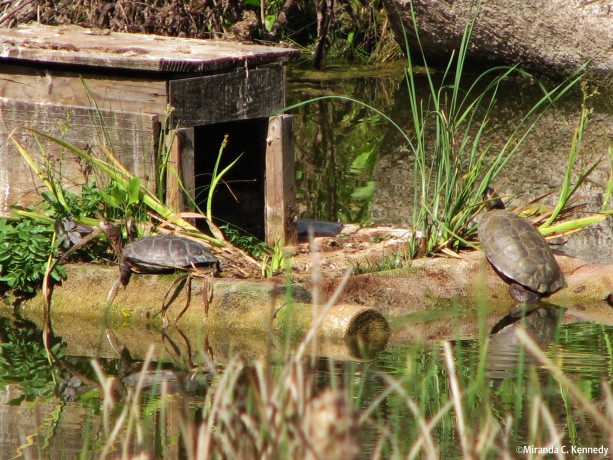
Click me, I takes you to Facebook! The Western Pond Turtle group which our Southern race (I think species status for pallida is still under study) belongs to, Actinemys marmorata, is an IUCN Red List “Vulnerable” species. This listing is due mostly to late 1800s to mid-1900s overharvest for food and extensive, continuing destruction and alteration of habitat. We simply don’t have wetlands anymore. They also struggle under pressures from invasive species such as Red-eared Sliders (Trachemys scripta elegans) — which will eat small pond turtles and usurp pond turtle habitat niches — and many other trials from the cornucopia of threats we offer our native species. Actinemys pallida‘s conservation status hasn’t been updated since 1996, and probably warrants at least the more critical status of “Threatened” by now.
Soooo, we were pretty excited to see not one, but two, apparently male and female judging by size, actual pond turtles in our pond. We’ve had visits from Red-eared Sliders, certainly, and captured and relocated them to sites which already have established slider populations that aren’t going anywhere. I’m afraid we haven’t the heart to kill them, so although we’re not reducing the problem, we are working to maintain an exclusive pond turtle club in our own pond.
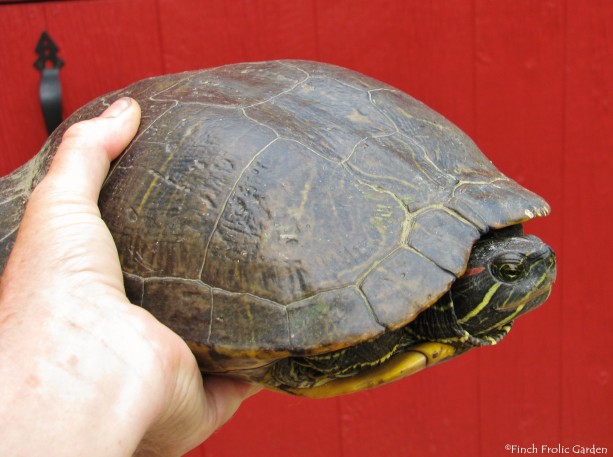
Adorable but sadly very destructive invasive species here in California. We were even more ecstatic when the pond turtles stayed. We’d catch glimpses of one or both of them all summer, until in the fall only the small one seemed to still be around, popping up on the duck raft to catch some sun in the warm afternoons. As it got colder, we saw him less often, but every now and then, we’d come round by the pond and there’d be the quiet “ploop” of a small scaly body slipping into the water.
The April pair, however, were not actually the first pond turtles we’d ever had on the property.
Back in July of 2011, our big pond was still under construction and was just a big dirt bowl with water in it, and lots of other activity was under way around it as old building materials were being moved and the garden being shaped.
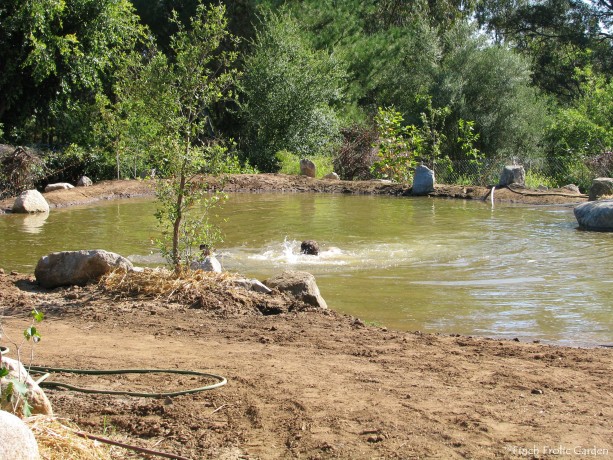
As you can see, the early pond had no habitat fit for anything except a pair of loons. (June 18, 2011) We were quite astonished, therefore, when Jacob Hatch (of Hatch Aquatics) who was managing the installation discovered a small turtle hiding in a stack of boards behind the pond. Delighted and bemused by the appearance of this usually wary and probably quite squashable reptile near our stark pond, around tractors and trucks, we examined it for injuries and to determine what species it was.
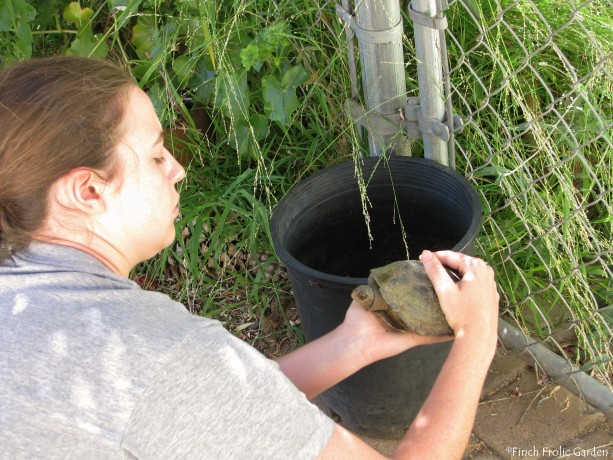
A comparison with the images and info. on the wonderful CaliforniaHerps website confirmed the stripeless turtle as a rare native Western Pond Turtle, and probably a female from the apparent concavity of her plastron (‘belly’ half of shell).
The most cursory examination, however, immediately revealed the turtle’s startling absence of a left front foot.
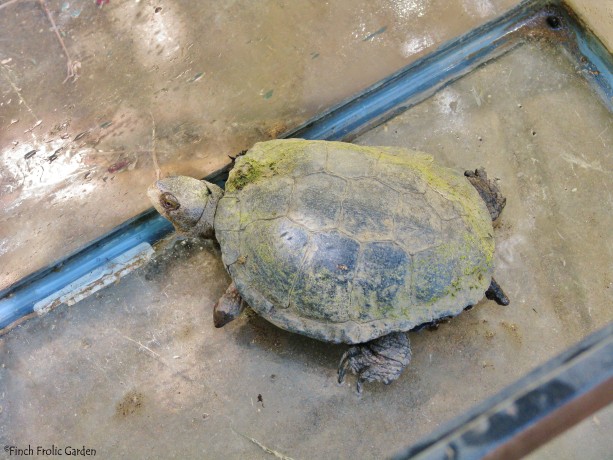
The wound was old and well-healed, and the turtle was admirably (Miranda-ishly) sprightly and seemingly unperturbed and unhindered by her partial flipperlessness.
Of course, we instantly dubbed the gimpy, watery, gimlet-eyed fighter ‘Rafael Sabatini’ (author of such famous swashbuckling tales as The Sea Hawk and Captain Blood). When we determined it was, in fact, a she, we respectfully redubbed her ‘Mrs. Sabatini’.
The second real Mrs. Rafael Sabatini, née Christine Dixon, I imagine to have been a person of some intelligence and depth of feeling, due to the fact that she had Rafael’s tombstone inscribed with “He was born with a gift of laughter and a sense that the world was mad”, the poignant first line of his novel of the French Revolution, Scaramouche.
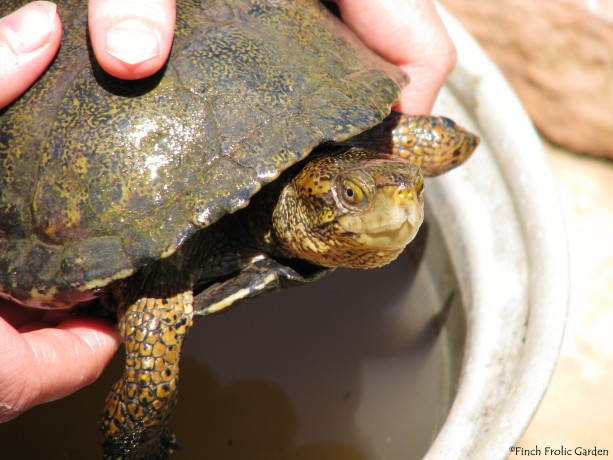
Our Mrs. Sabatini was certainly full of a sense of madness — at her unjust captivity! — so we quickly released her in the only place that seemed suitable and safe on the property: the small pond at the front of our house.
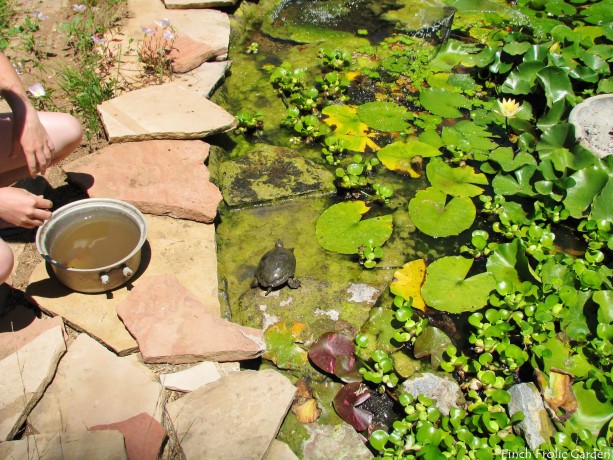
And that, despite our warm feelings of companionship and our admonishments to stay safe and show her face now and then, was the last we saw of the delightful Mrs. Sabatini.
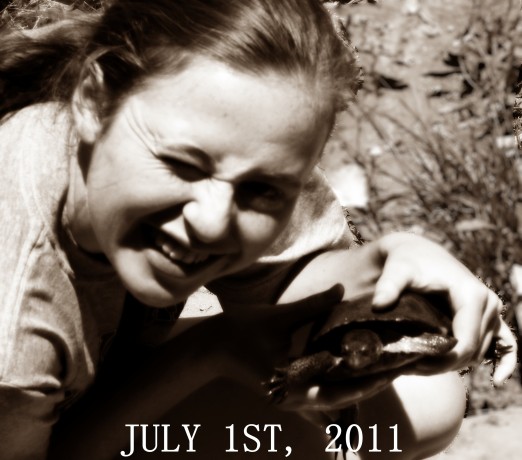
Life went on, as it does. And we gained that pond turtle couple last spring, so maybe-maybe we might end up with baby turtles here down the line. A distinguishing trait of a Shakespearean comedy (rather than a history or other) is that it ends with marriage, which implies future babies: it ends in the expectation of life. And I think Mrs. Sabatini would rather like the turtle story she was involved in to be a comedy — ‘gift of laughter’ and all. I can just imagine her rusty, grudging little whistly cackle guffing out as we fade to black.
However, in January this year, we began seeing multiple turtles in the pond again, rather than simply the lone male that had lingered into the fall. We became fearful that we’d been infiltrated by sliders again, as we’d see three turtles at once sunning on the raft — a new turtle maximum, and sliders are prolific and less picky about personal space. I had trouble getting good shots to check for the clearest field marks (the rounded vs. pointed shapes of the marginal scutes over the tail) so we were feeling rather turtle-scouraged, to be frank, a little turtle-glum. It’s difficult to catch a slider, but if we had them in the pond, as we had the grim feeling we did, they couldn’t stay or we’d risk all the balanced habitat we’d built up for our native species.
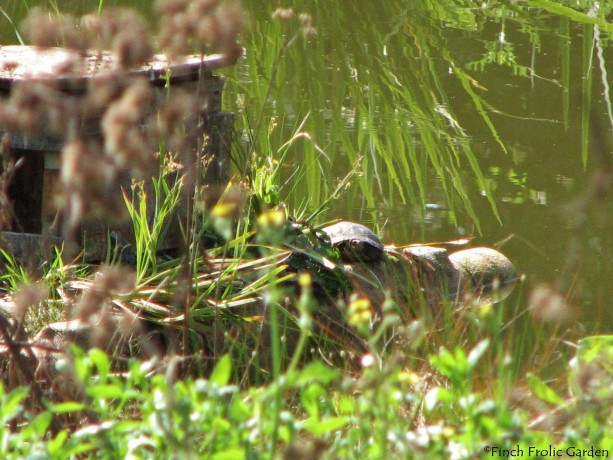
“Who am I? I’ll never tell! Keh-heh-heh-heh-hui! (neck in, neck in)!” Last night I decided to start catching up on my new year photo sorting. I take a lot of photos, and they all come off the camera into my ExternalHD Limbo on my desktop, where they’re eventually sorted and distributed to their homes in various folder nestings on my external harddrives. I’d managed to grab a few shots of the January turtles, and determined to examine them as best I could for slidery traits. It was time, I felt, to know for certain.
I pulled up a photo of a chummy pair of turtles I’d taken January 17th as they enjoyed the weak sunshine on the raft.
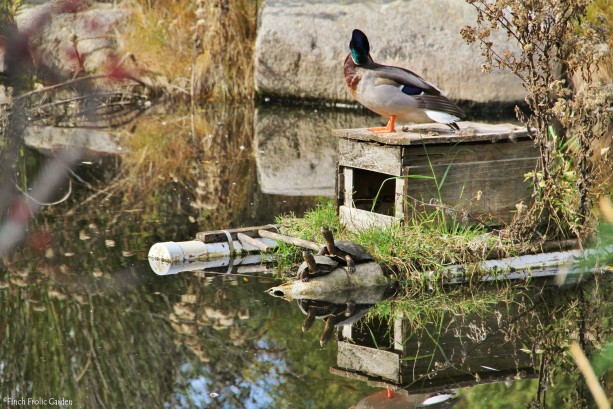
The resolution was good, so I was able to zoom in on their faces with fair clarity. Happily, I couldn’t see any stripes, red or yellow, on the face that would indicate a slider, and their chins looked mottled-yellow as pond turtles’ do.
Looking for more clues, I panned down from the faces along the necks and shells-fronts and —
— and there it was. Or there it wasn’t.
For on the smaller turtle, who was relaxing under the friendly claw of its chelonian compatriot, where there ought to have been a small reptilian left front leg — there was none.
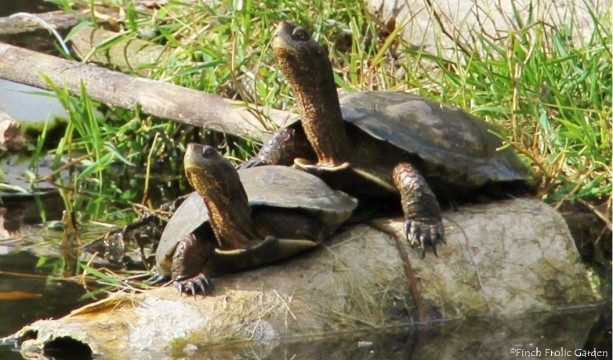
Mrs. Sabatini… had returned.
(Scaramouche, Scaramouche, she finds it difficult to do the fan-dan-go!)
“Faith, it’s an uncertain world entirely”! We certainly didn’t expect the same small, appendagially-impaired pond turtle to suddenly reappear in our pond after five years of absence.
Well, whether she’d truly been away or was simply being a lot more sneaky about using the pond so we never saw her, we’re exceedingly chuffed to know she’s back. She’s a jewel in our healthy, chemical-free habitat crown, and we’re pretty chuffed with ourselves for creating a safe, natural pond that she and her buddies — and so many other water-dependent species — can rely on.
If you build it, they will come — and come back!
Let’s keep making habitat for the small, wild, heart-pirating creatures in our lives, eh?
(Please direct Mrs. Sabatini fanmail c/o Finch Frolic Garden.)
M
